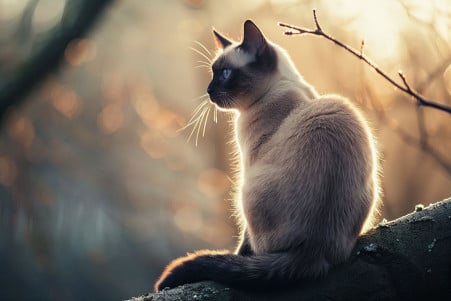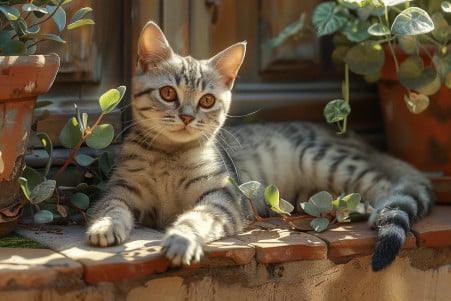Why Do Cats Puff Up Their Tails? The Science of Cat Tail Language
29 February 2024 • Updated 29 February 2024

If you’ve ever seen a cat’s tail go from sleek and streamlined to puffed up like a bottle brush, you’ve probably wondered why it happens. In the wild, cats puff up their tails to make themselves look bigger and more intimidating to potential predators or threats when they’re feeling scared or threatened, a behavior known as a defense mechanism.
In this way, tail puffing is a sign of fear or aggression and is an important part of a cat’s rich repertoire of body language cues.
In this article, we’ll delve into a variety of interdisciplinary research from the fields of animal behavior, veterinary science, and comparative psychology to try to get to the bottom of this question. Together, these areas of research can help us understand the physiological and psychological factors that lead to a cat puffing up its tail.
By learning about the science and subtleties of cat tail language, you can gain a greater understanding of your cat’s feelings and behavior.
Why do cats puff up their tails?
The Emotional Language of Cats: Why Do Cats Puff Their Tails?
Cats have a complex emotional language, and tail puffing is an important part of their non-verbal communication. From the signs of happiness to those of stress, a cat’s puffed tail can mean many things.
A puffed tail can be a sign of happiness during play or when being pet, or it can be a sign of fear or aggression when the cat feels threatened.
The situation in which a cat puffs its tail is important to understanding what it means—a playful puff is often accompanied by forward whiskers and pouncing, while a fearful puff is often accompanied by a hiss and an arched back.
Dr. Marc Bekoff, citing Dr. Sarah Brown’s book, “The Hidden Language of Cats,” notes that the evolutionary role of these signals is important.
Tail puffing is an example of an adaptive behavior that helps cats survive by communicating with other cats and even humans.
This form of communication has evolved from the cat’s ancestors’ reliance on scent to a more complex system that includes visual and tactile cues, which are important for social interactions and navigating their environment.
The Role of the Autonomic Nervous System and Tail Puffing in Cats
The autonomic nervous system is central to a cat’s stress response, including tail puffing. When a cat feels threatened, the autonomic nervous system is responsible for the body’s immediate, automatic response to the perceived danger. This response is not under conscious control and involves the release of hormones like adrenaline that flood the body, preparing the cat to fight or flee.
This hormonal response also leads to a number of physical changes, including an increased heart rate and the piloerection of fur, which causes the tail to puff up and makes the cat look bigger and more threatening.
As the Merck Veterinary Manual explains, conditions like feline dysautonomia, which is characterized by the loss of neurons in the autonomic nervous system, demonstrate the importance of the system to normal feline behavior.
Cats with feline dysautonomia can show a variety of signs, including abnormal tail posture and movement, which shows the autonomic nervous system’s importance in tail communication. Given this knowledge of the biological mechanisms, a deeper dive into the anatomy of a cat’s tail shows how the complex structure makes these important communications possible.
The Anatomy of a Cat’s Tail
The anatomy of a cat’s tail is evidence of the intricacy of their communication and balance systems. As noted by Wikipedia, the cat’s tail consists of a series of small bones called caudal vertebrae, which are encased in a detailed array of muscles, tendons, and ligaments.
These muscles give the tail a wide range of motion, from a gentle sway to the puffed-up look it takes on when a cat is scared.
Each of these motions is a form of communication, a language that is much more than just the puffed-up tail. For example, a twitch can mean a cat is annoyed, while a tail held high is a sign of confidence.
However, when injuries happen, as explained by Mar Vista Animal Medical Center, they can impact a cat’s ability to communicate through these specific motions. Tail dislocations or breaks can impact a cat’s communication, but they can also impact a cat’s fine motor skills, as the tail is used to help cats balance and move nimbly.
Knowing this, it’s important for cat owners to understand the importance of a cat’s tail, which goes far beyond its ability to puff up. The tail is a mood ring, a form of expression, and a key part of a cat’s physical well-being. This knowledge of tail anatomy sets the stage for understanding the many ways cats communicate with their environment and the people around them.
Stress Responses in the Animal Kingdom
From the lions of the African savannah to the domestic cats in our homes, the fight-or-flight response is a common theme in animal behavior.
A study in Integrative and Comparative Biology shows that vertebrate species have highly conserved this response, which includes the release of stress hormones and the activation of the autonomic nervous system.
However, this similarity is also highly diverse. When we see cats arch their backs and puff up their tails and rabbits freeze, we are seeing a range of stress responses that have been shaped by evolution.
A study by Roelofs in PMC shows that the autonomic nervous system is responsible for these responses, and that the decision to freeze or fight-or-flight is based on the level of threat.
In an editorial in PMC, Edward J. Narayan explains how environmental factors impact circadian rhythms, and therefore stress responses, in animals. This interaction between behavior, physiology, and the environment shows how complex stress is across different species.
This knowledge of the different ways animals respond to stress, from the arched tails of cats to the stiffened bodies of deer, can help us understand how animals, including our feline friends, deal with the stresses of their environments. This knowledge also helps us understand wildlife and can help us better understand our pets’ behaviors and needs.
Understanding Cat Body Language: What It Means When a Cat’s Tail Is Puffed
In order to respond properly, a puffed tail must be understood in context. As Joseph M. Plummer explains, a puffed tail during play, with forward-pointing whiskers and bouncy movements, is a sign of happiness and engagement.
On the other hand, a puffed tail with ears laid back and an arched back is a sign of fear. In response, owners should provide interactive toys to a cat that is playing and make sure they don’t startle it, and provide a safe space for a cat that is afraid.
International Cat Care stresses the importance of minimizing stress. A stable, calm environment with opportunities for climbing and hiding can help prevent unnecessary stress reactions.
The way that owners interact with their cats and give them space has a big impact on their stress levels. It’s important to notice when cats are showing signs of happiness or stress and adjust your behavior accordingly. By increasing environmental enrichment and paying attention to a cat’s signals, you can create a low-stress environment that makes it easier to understand and respond to a cat’s tail talk.
Making Sense of the Puffed Tail: Putting It All Together
In this article, we have delved into the many layers of meaning behind the mysterious phenomenon of the puffed-up cat tail. Yet, while a puffed tail is an important emotional barometer, it is also so much more.
It is an integral part of a complex biological and communicative network. From the adrenaline rush of the autonomic nervous system to the subtleties of feline emotional expression, each puff is a part of a larger system of feline body language.
The wonder of the cat tail’s anatomy is that it is perfectly adapted to balance the need for communication with the need for physical function. Yet, when we look at this in the context of animal behavior, we can see that cats are just one part of a much larger story of stress responses that have been honed by evolution across many species.
As we conclude our exploration of tail puffing, it’s important to take a moment to appreciate the intricate fabric of feline communication. For cat owners, the knowledge we’ve gained can lead to a deeper understanding and a closer bond with our feline companions. By understanding and responding to these signals, we can better appreciate the complexity of our cats’ behaviors and strengthen our special connections with our cherished pets.


